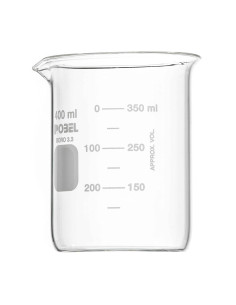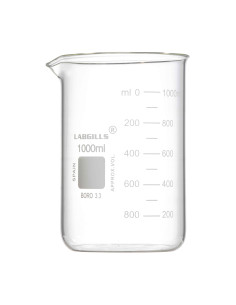The Griffin beaker is one of the most common tools in science laboratories, especially in those focused on chemistry and biology. This cylindrical beaker with a pouring spout and graduations is a versatile instrument used in various scientific practices—from mixing solutions to measuring liquids. Unlike other laboratory beakers, the Griffin beaker stands out for its specific design, making it a reliable choice for many lab tasks.
In this article, we’ll explore the features, origin, and uses of this type of beaker, as well as clarify how it differs from other laboratory beakers.
Origin and Design of the Griffin Beaker
The Griffin beaker is named after chemist and glassware manufacturer Richard Griffin, who pioneered its design and popularization. This beaker was created to facilitate laboratory work, providing a tool with a solid base and functional structure that allows safe and efficient handling of both liquids and solids.
Its cylindrical design with a pouring spout is known for being sturdy and user-friendly. It also includes a graduated scale, allowing for relatively accurate measurement of liquids. Thanks to its versatility, the Griffin beaker quickly became a standard in most scientific labs.
Key Features of the Griffin Beaker
The Griffin beaker has several features that make it ideal for use in laboratory environments. Below are its main attributes:
- Borosilicate Glass or Durable Plastic
Griffin beakers are made from high-quality materials such as borosilicate glass or chemical- and heat-resistant plastic. Borosilicate glass is especially useful because it withstands temperature changes and chemical exposure without breaking. - Visible Graduations
One of the most useful features is the clear graduated scale, which enables accurate liquid measurements. These markings are easy to read, minimizing errors during experiments. - Pouring Spout for Safe Transfer
The beaker includes a spout that allows liquids to be poured in a controlled manner, preventing spills. This is essential when handling hazardous or sensitive substances. - Flat Bottom for Stability
The flat base provides excellent stability, helping the beaker remain in place during mixing or heating. This is especially important during procedures involving heat or stirring. - Wide Range of Sizes
Griffin beakers come in a variety of sizes, typically ranging from 50 ml to 2000 ml, allowing scientists to choose the right volume for their experiments.
Differences Between Griffin Beakers and Other Lab Beakers
The Griffin beaker distinguishes itself from other types of beakers through its specific design and versatility. Here's a comparison with other common laboratory vessels:
- Measuring Beaker: unlike measuring beakers designed for high-precision volume measurements, Griffin beakers are more multi-purpose, ideal for mixing, heating, or holding substances. Though both have graduations, measuring beakers are more accurate.
- Round-Bottom Flask: these have a rounded base that offers less stability than the flat-bottomed Griffin beaker. When stability during heating or mixing is important, the Griffin is preferred.
- Bottles and Flasks: these are typically used for long-term storage. In contrast, the Griffin beaker is mainly used for transferring, mixing, or heating liquids during experiments.
When to Choose a Griffin Beaker Over Others
A Griffin beaker is chosen when you need a sturdy, stable, and multipurpose container for lab work involving mixing, heating, or measuring liquids. Measuring beakers are better suited for precise volume determination, while bottles and flasks are ideal for storage purposes.
Common Uses of the Griffin Beaker in the Laboratory
Griffin beakers have a wide variety of applications in science labs. Some common uses include:
- Heating Liquids
Ideal for heating due to its heat resistance, especially when made from borosilicate glass. They can be placed over a direct heat source or in a water bath. - Mixing and Preparing Solutions
The beaker's shape makes it suitable for mixing both liquids and solids, aiding in solution preparation across various scientific fields. - Controlled Pouring
The spout allows for accurate and safe transfer of liquids—essential for handling hazardous chemicals. - Pre-Weighing Substances
Frequently used to weigh solids and liquids before mixing. Their stability and durability make them an excellent choice for this task. - Collecting Filtrates
Used to collect filtered liquids during filtration processes. Their large volume capacity is particularly useful here.
Buy Griffin Beakers at Pobel
If you’re looking for high-quality Griffin beakers, Pobel is your ideal choice. We offer a wide selection of beakers suitable for different lab needs. Our products are made from durable, resistant materials, ensuring outstanding performance. We also provide technical guidance to help you select the right beaker for your work.
Shop Griffin beakers for your lab at Pobel today.
Frequently Asked Questions
Can a Griffin beaker be heated directly over a flame?
Yes, especially those made of borosilicate glass, as they can withstand high temperatures without breaking.
What’s the difference between a glass and plastic Griffin beaker.
Glass (borosilicate) is more resistant to heat and chemicals, while plastic beakers are lighter and less fragile but can’t handle high temperatures.
What capacities are available for Griffin beakers?
They are available in various sizes, ranging from 50 ml to 2000 ml, letting you choose based on the experiment’s requirements.








